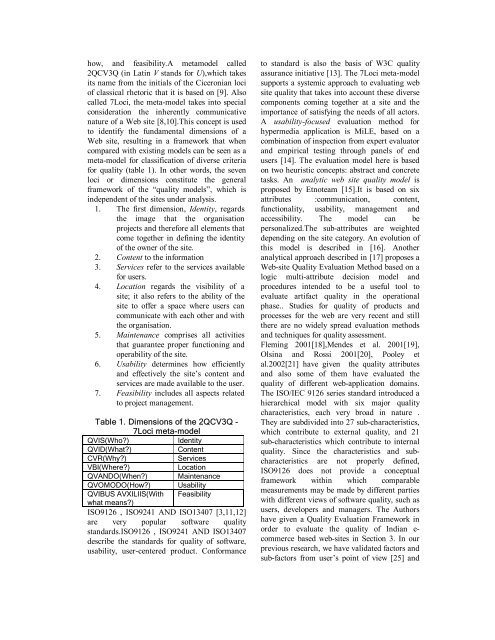Quality Evaluation of Web-sites of Indian E-commerce Domain
Quality Evaluation of Web-sites of Indian E-commerce Domain
Quality Evaluation of Web-sites of Indian E-commerce Domain
Create successful ePaper yourself
Turn your PDF publications into a flip-book with our unique Google optimized e-Paper software.
how, and feasibility.A metamodel called<br />
2QCV3Q (in Latin V stands for U),which takes<br />
its name from the initials <strong>of</strong> the Ciceronian loci<br />
<strong>of</strong> classical rhetoric that it is based on [9]. Also<br />
called 7Loci, the meta-model takes into special<br />
consideration the inherently communicative<br />
nature <strong>of</strong> a <strong>Web</strong> site [8,10].This concept is used<br />
to identify the fundamental dimensions <strong>of</strong> a<br />
<strong>Web</strong> site, resulting in a framework that when<br />
compared with existing models can be seen as a<br />
meta-model for classification <strong>of</strong> diverse criteria<br />
for quality (table 1). In other words, the seven<br />
loci or dimensions constitute the general<br />
framework <strong>of</strong> the “quality models”, which is<br />
independent <strong>of</strong> the <strong>sites</strong> under analysis.<br />
1. The first dimension, Identity, regards<br />
the image that the organisation<br />
projects and therefore all elements that<br />
come together in defining the identity<br />
<strong>of</strong> the owner <strong>of</strong> the site.<br />
2. Content to the information<br />
3. Services refer to the services available<br />
for users.<br />
4. Location regards the visibility <strong>of</strong> a<br />
site; it also refers to the ability <strong>of</strong> the<br />
site to <strong>of</strong>fer a space where users can<br />
communicate with each other and with<br />
the organisation.<br />
5. Maintenance comprises all activities<br />
that guarantee proper functioning and<br />
operability <strong>of</strong> the site.<br />
6. Usability determines how efficiently<br />
and effectively the site’s content and<br />
services are made available to the user.<br />
7. Feasibility includes all aspects related<br />
to project management.<br />
Table 1. Dimensions <strong>of</strong> the 2QCV3Q -<br />
7Loci meta-model<br />
QVIS(Who?) Identity<br />
QVID(What?) Content<br />
CVR(Why?) Services<br />
VBI(Where?) Location<br />
QVANDO(When?) Maintenance<br />
QVOMODO(How?) Usability<br />
QVIBUS AVXILIIS(With Feasibility<br />
what means?)<br />
ISO9126 , ISO9241 AND ISO13407 [3,11,12]<br />
are very popular s<strong>of</strong>tware quality<br />
standards.ISO9126 , ISO9241 AND ISO13407<br />
describe the standards for quality <strong>of</strong> s<strong>of</strong>tware,<br />
usability, user-centered product. Conformance<br />
to standard is also the basis <strong>of</strong> W3C quality<br />
assurance initiative [13]. The 7Loci meta-model<br />
supports a systemic approach to evaluating web<br />
site quality that takes into account these diverse<br />
components coming together at a site and the<br />
importance <strong>of</strong> satisfying the needs <strong>of</strong> all actors.<br />
A usability-focused evaluation method for<br />
hypermedia application is MiLE, based on a<br />
combination <strong>of</strong> inspection from expert evaluator<br />
and empirical testing through panels <strong>of</strong> end<br />
users [14]. The evaluation model here is based<br />
on two heuristic concepts: abstract and concrete<br />
tasks. An analytic web site quality model is<br />
proposed by Etnoteam [15].It is based on six<br />
attributes :communication, content,<br />
functionality, usability, management and<br />
accessibility. The model can be<br />
personalized.The sub-attributes are weighted<br />
depending on the site category. An evolution <strong>of</strong><br />
this model is described in [16]. Another<br />
analytical approach described in [17] proposes a<br />
<strong>Web</strong>-site <strong>Quality</strong> <strong>Evaluation</strong> Method based on a<br />
logic multi-attribute decision model and<br />
procedures intended to be a useful tool to<br />
evaluate artifact quality in the operational<br />
phase.. Studies for quality <strong>of</strong> products and<br />
processes for the web are very recent and still<br />
there are no widely spread evaluation methods<br />
and techniques for quality assessment.<br />
Fleming 2001[18],Mendes et al. 2001[19],<br />
Olsina and Rossi 2001[20], Pooley et<br />
al.2002[21] have given the quality attributes<br />
and also some <strong>of</strong> them have evaluated the<br />
quality <strong>of</strong> different web-application domains.<br />
The ISO/IEC 9126 series standard introduced a<br />
hierarchical model with six major quality<br />
characteristics, each very broad in nature .<br />
They are subdivided into 27 sub-characteristics,<br />
which contribute to external quality, and 21<br />
sub-characteristics which contribute to internal<br />
quality. Since the characteristics and subcharacteristics<br />
are not properly defined,<br />
ISO9126 does not provide a conceptual<br />
framework within which comparable<br />
measurements may be made by different parties<br />
with different views <strong>of</strong> s<strong>of</strong>tware quality, such as<br />
users, developers and managers. The Authors<br />
have given a <strong>Quality</strong> <strong>Evaluation</strong> Framework in<br />
order to evaluate the quality <strong>of</strong> <strong>Indian</strong> e<strong>commerce</strong><br />
based web-<strong>sites</strong> in Section 3. In our<br />
previous research, we have validated factors and<br />
sub-factors from user’s point <strong>of</strong> view [25] and
















